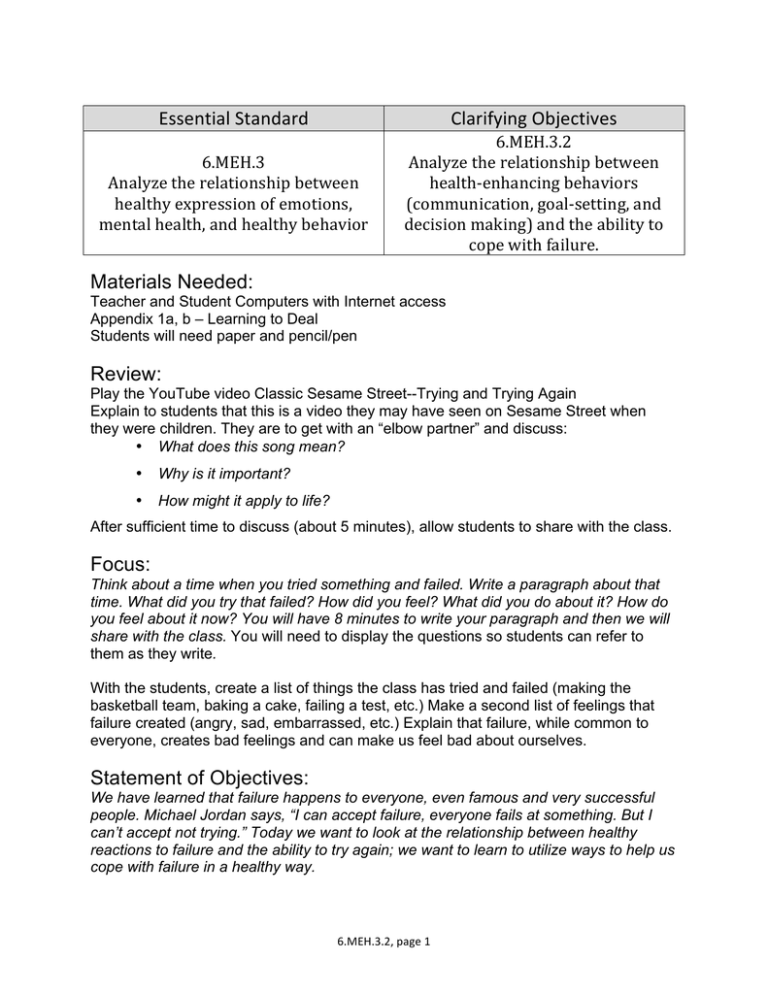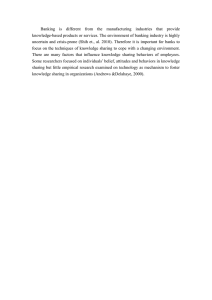Essential Standard Clarifying Objectives Materials Needed
advertisement

Essential Standard Clarifying Objectives 6.MEH.3 Analyze the relationship between healthy expression of emotions, mental health, and healthy behavior 6.MEH.3.2 Analyze the relationship between health-­‐enhancing behaviors (communication, goal-­‐setting, and decision making) and the ability to cope with failure. Materials Needed: Teacher and Student Computers with Internet access Appendix 1a, b – Learning to Deal Students will need paper and pencil/pen Review: Play the YouTube video Classic Sesame Street--Trying and Trying Again Explain to students that this is a video they may have seen on Sesame Street when they were children. They are to get with an “elbow partner” and discuss: • What does this song mean? • Why is it important? • How might it apply to life? After sufficient time to discuss (about 5 minutes), allow students to share with the class. Focus: Think about a time when you tried something and failed. Write a paragraph about that time. What did you try that failed? How did you feel? What did you do about it? How do you feel about it now? You will have 8 minutes to write your paragraph and then we will share with the class. You will need to display the questions so students can refer to them as they write. With the students, create a list of things the class has tried and failed (making the basketball team, baking a cake, failing a test, etc.) Make a second list of feelings that failure created (angry, sad, embarrassed, etc.) Explain that failure, while common to everyone, creates bad feelings and can make us feel bad about ourselves. Statement of Objectives: We have learned that failure happens to everyone, even famous and very successful people. Michael Jordan says, “I can accept failure, everyone fails at something. But I can’t accept not trying.” Today we want to look at the relationship between healthy reactions to failure and the ability to try again; we want to learn to utilize ways to help us cope with failure in a healthy way. 6.MEH.3.2, page 1 NC School Health Training Center NC Association for the Advancement of Health Education Teacher Input: To be healthy, one must practice health-enhancing behaviors. While knowing that failure can be overcome is important, taking action is the key to coping with failure effectively. Some of these health-enhancing behaviors are communication, setting goals, and making decisions. Having those skills makes it possible to manage a setback. (Put communication, setting goals and making decisions on the board. In the next part of the lesson, you will list examples of each behavior as students think of personal experiences and ideas.) Some examples of using health enhancing behaviors to cope with failure are: • Failing a math test: asking the math teacher for additional help. This is an example of which healthy behavior? (Communication—add this activity to that column) Can you think of other examples where communication is a healthy reaction to failure? (List these under communication) • Not making the starting line-up in basketball: listing steps to take to be a starter next year by attending summer camp. This is an example of which healthy behavior? (Goal setting—add this activity to the appropriate column.) Can you think of other examples where goal setting is a healthy reaction to failure? (List these under goal setting) • Experiencing the break-up of a friendship: making the choice to take part in activities to make new friends (Decision making—add this activity to the appropriate column.) Can you think of other examples where decision making is a healthy reaction to failure? (List these under decision making) The rewards of coping with failure are many. Some of those are enhanced self-esteem, improved confidence, and a greater willingness to take risks in the future. It is not possible to live life (or even sixth grade) without failure in some areas or at some times. While not fun, failure can be a growth experience and provide unanticipated opportunities. One of the healthiest ways to cope with failure is to use positive self-talk. Examples would be: “I know I can do this,” “I succeeded before and I’ll do it again,” “I’ve practiced and practiced. I have the skills that I need to accomplish my goals.” Let’s take a closer look at goal setting, one of the three healthy reactions to failure. What is a goal? (A goal is a target that you want to meet.) Using the website 5 Facts About Goal Setting from KidsHealth.org, discuss with the class the practical tips on setting and reaching goals. Have the class identify a goal and analyze it in terms of the five facts below. 1. Specific, realistic goals work best. 2. It takes time for a change to become an established habit. 3. Repeating a goal makes it stick. 4. Pleasing other people doesn’t work. 5. Roadblocks do not mean failure. 6.MEH.3.2, page 2 NC School Health Training Center NC Association for the Advancement of Health Education Guided Practice: Each student will need a computer with internet access. Students should be directed to the website Making a Change in Your Life. Students are to set a personal goal; encourage them to make the goal something they are serious about achieving. Students should follow the directions using the goal planning book “Making a Change.” Each student can print a copy of his/her goal-setting sheet at the end of the exercise. If computers are not available, the activity can be modified to be done with paper and pencil only. At the end of the activity allow volunteers to share their goals. Emphasize the importance of setting realistic goals and that it takes work for a goal to be met. Dealing with failure by setting goals to overcome the disappointment is a health enhancing behavior and one that students can use throughout their lives. Independent Practice: Provide each student a copy of the handout, Learning to Deal (Appendix 1a, b). Students are to complete this activity with a partner. (An alternative would be to place students in groups of three and assign each group two situations to complete. Groups are responsible for explaining their situations and answers to the questions.) Be prepared to assist each pair or group with positive ways to deal with each of these failures. Conclude this activity by emphasizing that all individuals experience temporary setbacks and failure. Emphasize the importance of positive thinking when he/she experiences disappointment. If we can think positively when we encounter problems, it can help us accept setbacks or failure and give us the courage to start again. If the goal we did not accomplish is something that we really want to do, we must determine what is necessary to increase our chances of being successful. (Example: Practice our athletic skills to make the team next year.) Learning how to handle our failures in a positive way helps us to maintain a healthy self-esteem. Closure: Today we have completed our second lesson on overcoming failure. You should now be able to use healthy behaviors such as communication, goal setting and decision making to cope with failure in a positive way. By using health-enhancing behaviors you will develop a positive self-image and have the commitment to “try, try again.” 6.MEH.3.2, page 3 Learning to Deal 1) Jordan did not make the basketball team. He went home and told his parents he didn’t make the team because the coach was a jerk and didn’t like him. Jordan suggests to his parents that he switch schools. • How is Jordan dealing with his failure? • Is this the best way to deal with the situation? Why or Why not? • What might be a better way to deal with the situation? 2) Bre broke up with Wesley at the end of football season. She just didn’t feel the same about him anymore. Wesley told everyone that Bre broke up with him because football season was over and that she had just been using him because he was the star quarterback. • How is Wesley dealing with his break-­‐up? • Is this the best way to deal with the situation? Why or Why not? • What might be a better way to deal with the situation? 3) Mariah is a 5th grader who decided not to try out for cheerleading for the next school year. Even though she had been a cheerleader for the youth football league during elementary school, she did not believe that she would make the cheerleading squad at her middle school. • Why did Mariah decide not to try out for the cheerleading team? • Is this the best decision? Why or Why not? • What might be the benefits of her trying out? 6.MEH.3.2, Appendix 1a 4) Matt came home mad! He told his parents he hated his math teacher. He had failed his test because the teacher had made it too hard. He truly believed that he had gotten a different test than his friends who passed the test. Matt decided he would quit doing his homework because his teacher was out to get him. • How is Matt dealing with his failure on his test? • Is this the best way to deal with the situation? Why or Why not? • What might be a better way to deal with the situation? 5) Brad ran off the soccer field. He was so angry at his teammates. None of them seemed to hustle at all. It seemed as if they didn’t care whether their team won or lost. The goalie did not stop any attempted shots. He hated being on this team and he let everyone know. • How is Brad dealing with the team’s loss? • Is this the best way to deal with the situation? Why or Why not? • What might be a better way to deal with the situation? 6) Jeremiah decided not to enter his artwork in an art contest that his art teacher had suggested. Jeremiah was afraid that his artwork would not win even though his teacher said it was the best drawing in the sixth grade. • Why did Jeremiah decide not to enter the contest? • Is this the best decision? Why or Why not? • What might be the benefits of him entering the contest? 6.MEH.3.2, Appendix 1b


